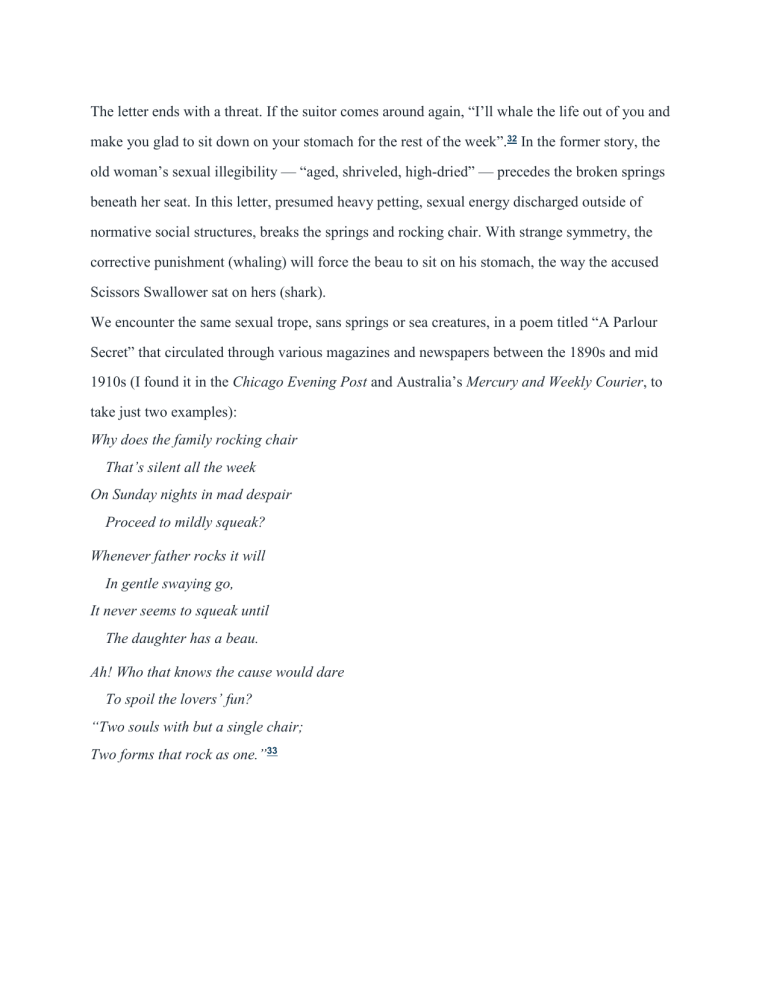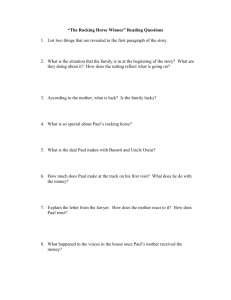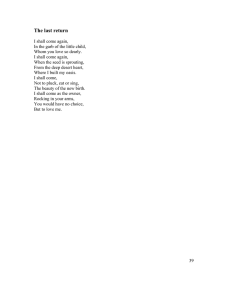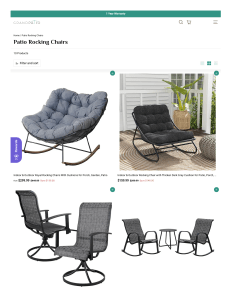
The letter ends with a threat. If the suitor comes around again, “I’ll whale the life out of you and make you glad to sit down on your stomach for the rest of the week”.32 In the former story, the old woman’s sexual illegibility — “aged, shriveled, high-dried” — precedes the broken springs beneath her seat. In this letter, presumed heavy petting, sexual energy discharged outside of normative social structures, breaks the springs and rocking chair. With strange symmetry, the corrective punishment (whaling) will force the beau to sit on his stomach, the way the accused Scissors Swallower sat on hers (shark). We encounter the same sexual trope, sans springs or sea creatures, in a poem titled “A Parlour Secret” that circulated through various magazines and newspapers between the 1890s and mid 1910s (I found it in the Chicago Evening Post and Australia’s Mercury and Weekly Courier, to take just two examples): Why does the family rocking chair That’s silent all the week On Sunday nights in mad despair Proceed to mildly squeak? Whenever father rocks it will In gentle swaying go, It never seems to squeak until The daughter has a beau. Ah! Who that knows the cause would dare To spoil the lovers’ fun? “Two souls with but a single chair; Two forms that rock as one.”33 A couple sharing a rocking chair in a postcard by Bamforth & Co, a West Yorkshire film and illustration company known for their risqué, seaside content (1907) — Source. Adopting a cliché from Friedrich Halm’s play Ingomar, The Barbarian, this poem reduces spiritual ecstasy to physical intimacy.34 I do not know enough about sex in the nineteenth century to wager on the act. Furtive lap sitting? A variation of the Kama Sutra’s love swing? Or is the rocking chair a sonic euphemism, providing a more palatable source for the squeaking? We lack a history of the bodily techniques associated with springs and rocking furniture: a creaking mattress in the in-laws’ guestroom; the childhood taboo against jumping on beds; or murderous recliners. But I do know that upholstery springs and rocking chairs furnished Victorian erotic writing. For example, this scene from The Romance of Lust, published in the 1870s: There was a perfectly shaded walk in the east shrubbery leading from the greenhouse down to a most charming summer house overlooking the very finest prospect, and perfectly secure from all observation. It was furnished very appropriately for amorous purposes, the couches being low, broad, and with patent spring-cushions. In the sequel it was the scene of many a bout of lubricity.35 Or, let me proffer this creepy excerpt from the third volume of My Secret Life, an obsessive, million-word, highly pornographic “memoir” that began appearing in the late 1880s: By the sofa was an American rocking-chair, the first I ever recollect having seen. Matilda began rocking herself in it, I rocked the chair violently for her and then as far as it would go, back and held it there, then rapidly I pushed one hand up her petticoats.36 Rocking chairs (and seats that rocked) carried an erotic charge in the nineteenth century, approximating, perhaps, a tumble dryer before its time. For a certain type of Victorian mind, easy chairs made easy women. Polite society sat erect. Some American commentators found these English regimens laughable. “I am told that the English nation sit bolt upright, like mummies”, wrote the humorist Fanny Fern in “A Chapter on Chairs” for The London Reader (1864). “Poor creatures! No wonder they are so red in the face.”37 While rocking chairs had been around America since the early eighteenth century, they did not fully enter the European consciousness until the 1830s, when travelers to the United States began commenting on their ubiquity. “In America”, wrote James Frewin for The Architectural Magazine and Journal in 1838, “it is considered a compliment to give the stranger the rockingchair as a seat; and when there is more than one kind in the house, the stranger is always presented with the best.” Not everyone appreciated the gesture. That same year, in her Retrospect of Western Travel, the British social theorist Harriet Martineau stops off at a small inn between Stockbridge and Albany, New York. She describes “the disagreeable practice” of rocking in chairs and finds “ladies who are vibrating in different directions, and at various velocities, so as to try the head of a stranger almost as severely as the tobacco chewer his stomach.”38 A similar description later appeared in the Michigan Farmer and other magazines, echoing both the rocker’s nicotinic effects and asynchronicity; the author calls rocking chairs a woman’s “nervine, a narcotic, a stimulant”, and describes “a woman photographer [who] would sit in a rocker with a camera in her lap and placidly photograph a group of rocking women in rockers of various gaits”.39




